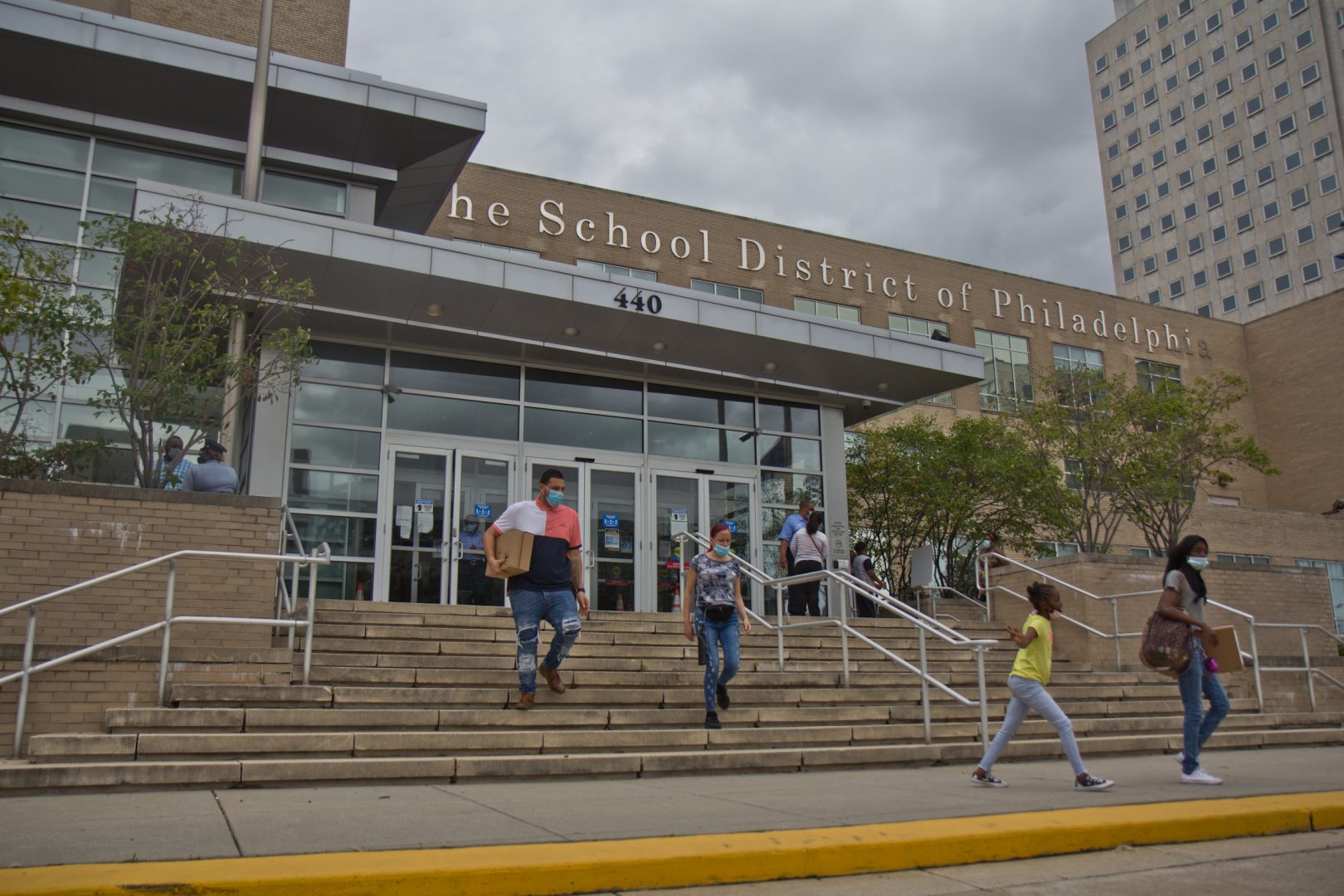
Families stand in line at Philadelphia School District headquarters to pick up Chrome books ahead of the start of the school year Wednesday. (Kimberly Paynter/WHYY)
Kimberly Paynter / WHYY

Families stand in line at Philadelphia School District headquarters to pick up Chrome books ahead of the start of the school year Wednesday. (Kimberly Paynter/WHYY)
Kimberly Paynter / WHYY

Kimberly Paynter / WHYY
Families stand in line at Philadelphia School District headquarters to pick up Chrome books ahead of the start of the school year Wednesday. (Kimberly Paynter/WHYY)
(Philadelphia) — Jerry Logan, 68, can’t afford not to be serious about COVID-19 safety.
He’s a single father of two school-aged children and takes care of his 93-year-old mother at their North Philadelphia home.
“We can’t afford for her to get sick,” he said.
Weighing the risks, though, he couldn’t justify keeping his children in full-time virtual school.
“They’ve got to make up some of this time. They’ve been out of school almost a whole year.”
So although Logan has lost friends and distant family members to the virus, he opted for his kids to return to in-person school at Kenderton Elementary for two days a week starting today.
Kenderton is one of 53 buildings in the School District of Philadelphia reopening for about 2,600 pre-K through second graders — the first time district students are back in classrooms since last March.
This comes after multiple failed reopening attempts and months of debate between district officials and the Philadelphia Federation of Teachers.
The district had planned to reopen 152 school buildings in February, but after prolonged mediation, agreed to reopen buildings in weekly phases. At a press conference last week, union, district, and city officials said the first 53 buildings were selected because all parties agreed they were properly ventilated and safe learning environments.
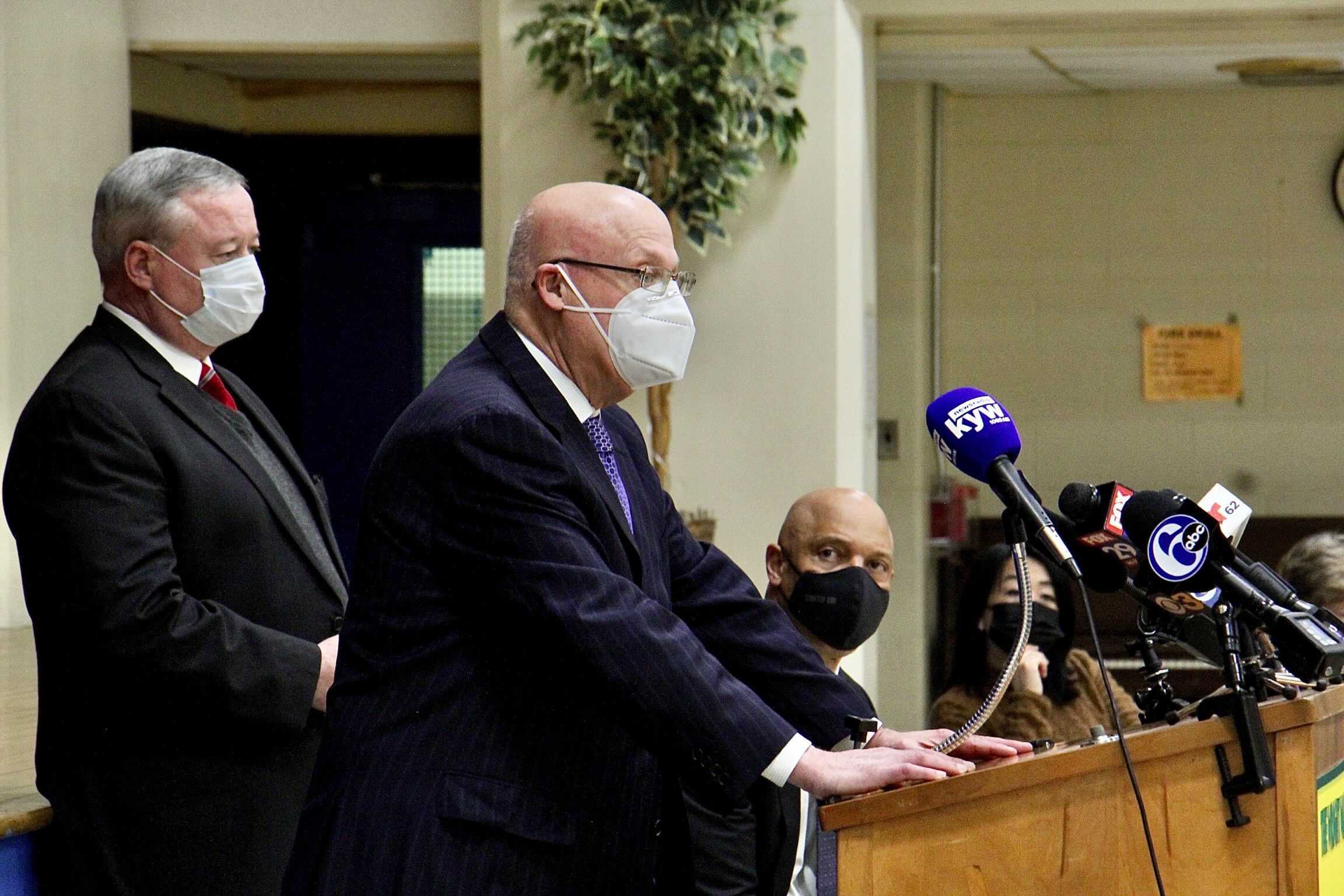
AFT Pennsylvania President Arthur Steinberg (center) joins Mayor Jim Kenney (left) and schools Superintendent William Hite to announce a plan for reopening some Philadelphia school buildings. (Emma Lee/WHYY)
Logan visited Kenderton himself to check out the precautions. He was satisfied with the classroom setup, noting the distancing measures and desk partitions. He also plans to take his kids’ temperatures when they get home from school.
A big part of Logan’s motivation was that he has struggled to keep his daughters focused. On school days, he moves from one laptop to the next, assisting both simultaneously. But at a “young 68,” he can’t keep up, and they watch YouTube videos and play games when his back is turned.
He says the kids often have issues logging in to classes while he is caring for his mother. Then, they get marked absent. He has received numerous alerts from the school about truancy.
He said that was never a problem before COVID, when he would oversee pick-up and drop-off.
“Their job is to go to school to learn something,” he said. “My job is to make sure they get there.”
Teachers like Samantha Rutherford can sympathize with parents who want their kids back in classrooms, agreeing that such a long break from in-person learning is “scary.”
But skepticism over building readiness lingers in many city educators.
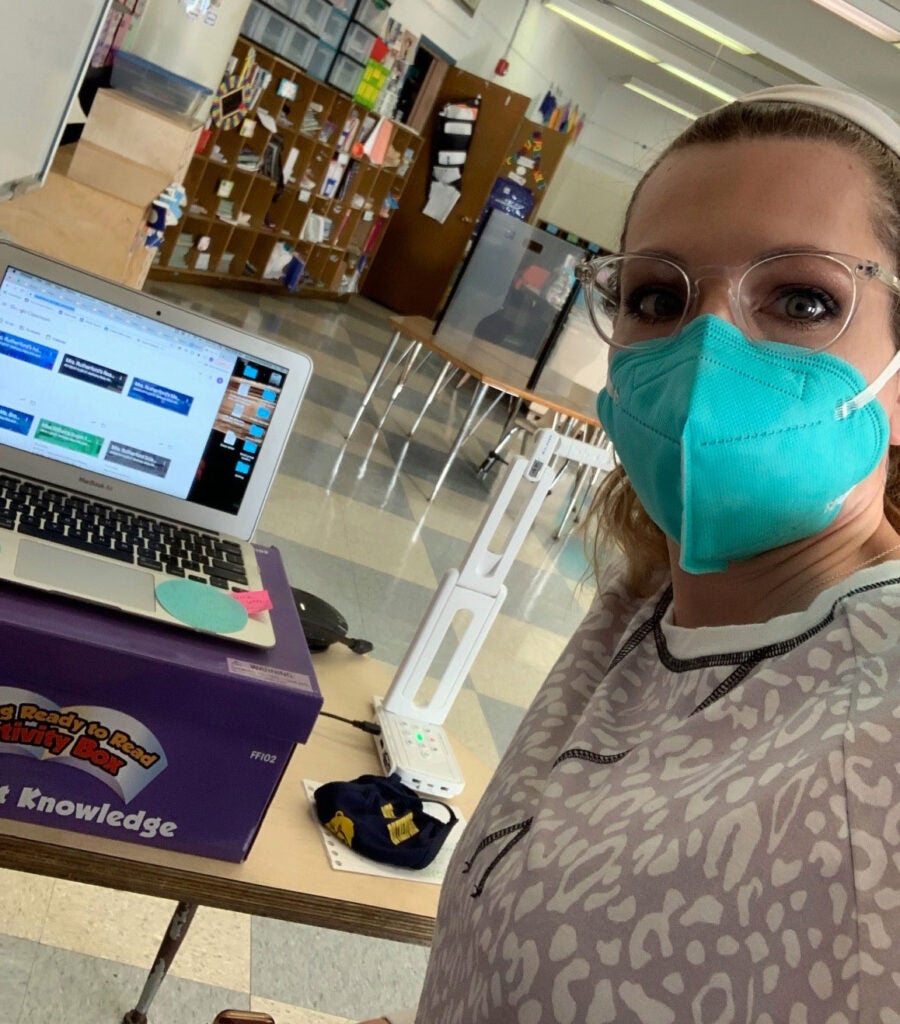
Samantha Rutherford wears a face mask inside Mary McLeod Bethune Elementary. (Courtesy of Samantha Rutherford)
Rutherford, a kindergarten teacher at Mary McLeod Bethune Elementary, was not encouraged last week when, entering her classroom for the first time in months, she found it covered in black dust, cockroaches, and mouse feces.
After cleaning and setting up her room, moving tables and chairs six feet apart, Rutherford’s hands were covered in filth. When asked how she felt about her building reopening, she mustered the words, “stressed, tired, nervous.”
According to Rutherford, teachers were assured that maintenance would clean every classroom before their arrival.
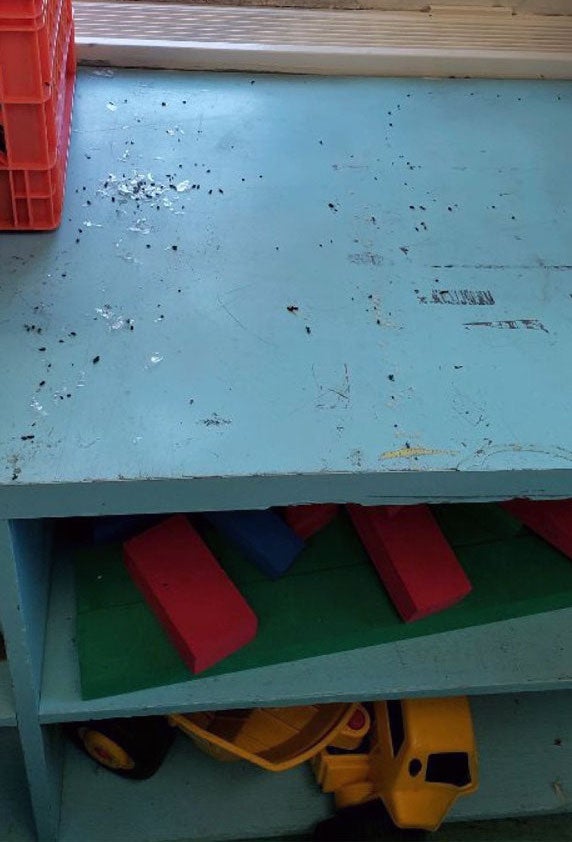
A look inside Samantha Rutherford’s classroom at Mary McLeod Bethune Elementary when she arrived Wednesday, March 3, 2021. (Courtesy of Samantha Rutherford)
But, instead of prepping for the difficulty of hybrid teaching, Rutherford said she was frustrated she needed to do “another job that I was told I didn’t have to do.”
Rutherford has also been confused by the district’s ventilation report for Bethune. The corridors are listed as safe for zero occupants. In the reports for many other schools, hallways aren’t listed at all. Rutherford has been asking union reps and school leaders for an explanation, but hasn’t gotten answers. She’ll need to use the stairwell to walk her students back and forth from the cafeteria.
“I don’t feel safe walking in the stairwell,” she said. “How do you justify that?”
After all of her preparation and anxiety, she’s scheduled to teach just one student in person on Monday. The rest of her class will be virtual. On Thursdays and Fridays, four students are set to be in the classroom.
Siobhan Dotson, music teacher at Southwark School in South Philly, says specialist teachers feel especially vulnerable because they circulate around buildings, interacting with different cohorts of kids.
“We are the most at risk, and we are the last to be considered and thought of,” said Dotson. “I miss the kids dearly. It’s not about that.”
Dotson noted that district leaders frequently use the words “we’re all in this together.” But she feels otherwise. “We are not in this together,” she said. “This is an every-man-for-himself mentality.”
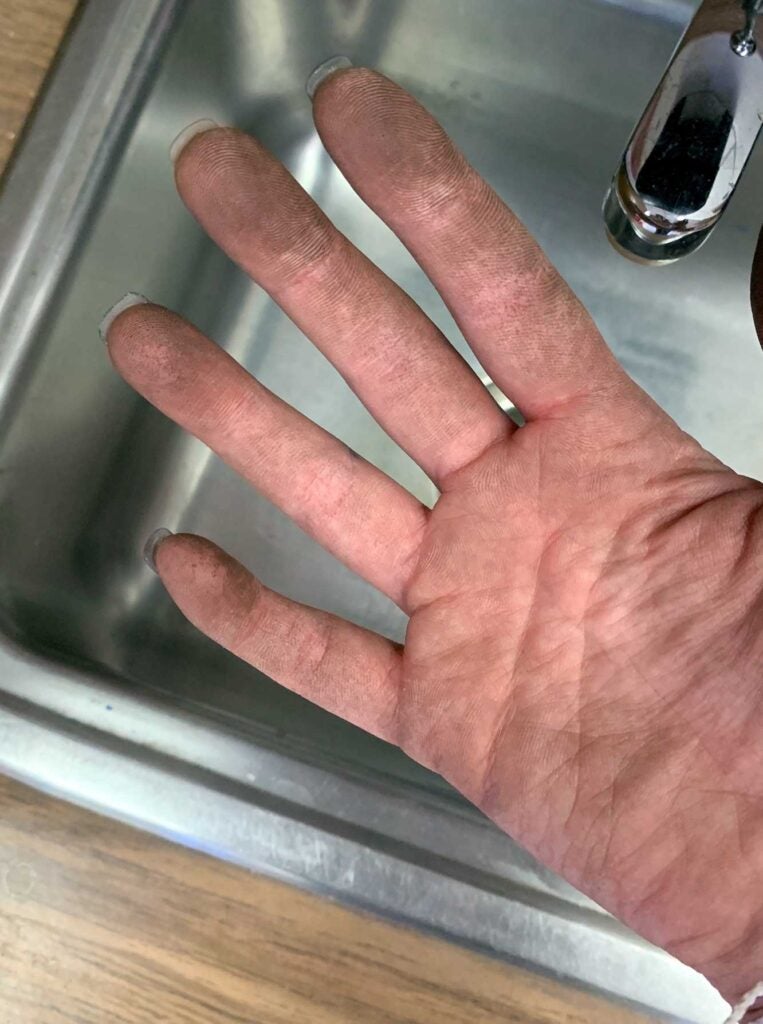
Rutherford’s hands covered in dust after cleaning her classroom. (Courtesy of Samantha Rutherford)
Her fear around the spread of COVID-19 comes from experience. She tested positive over the summer, and still feels the after-effects, the lack of taste and smell. Her cousin also had the coronavirus, and consequently developed epilepsy.
Both teachers wondered why the district could not wait until all teachers are vaccinated, which city health officials recently said could happen by early April.
Union leaders had previously said it would be “foolish” to reopen schools before all educators are vaccinated, but abandoned that demand in its latest agreement. Guidance from local and national health experts has backed school reopening prior to inoculation.
The academic implications of the return are another question. Dotson and Rutherford are both unsure of how they will teach virtual and in-person students simultaneously — something teachers in the suburbs have struggled with as well.
“It’s like riding a bike, flying a plane, all at the same time. They’re telling us to do the impossible here,” said Dotson.
Rutherford said when teaching virtually, she sees her students doing all sorts of things, like standing on chairs, requiring her to closely monitor the screen.
She wonders which set of students is going to miss her undivided attention more.
“Is it going to be the kids that are on the screen that are going to miss out because I’m trying to help a student that’s in the classroom who’s having login issues?” she said. “Is the student in the classroom going to get upset because I’m trying to help the kids on the screen?”
Laura Bauer’s son, Jaxon, is returning to Stephen Decatur Elementary in Northeast Philly. Bauer talks to Jaxon’s kindergarten teacher every day, and has made sure that she’s comfortable returning to the building.
“You don’t want to feel like, if I opt my kid in, am I making the choice for somebody else?” she said.
Her oldest son, Logan, is in eighth grade, and with ADHD, has struggled with virtual school.
“I’ve never seen him have a breakdown like this. It’s every week he’s in tears,” said Bauer.
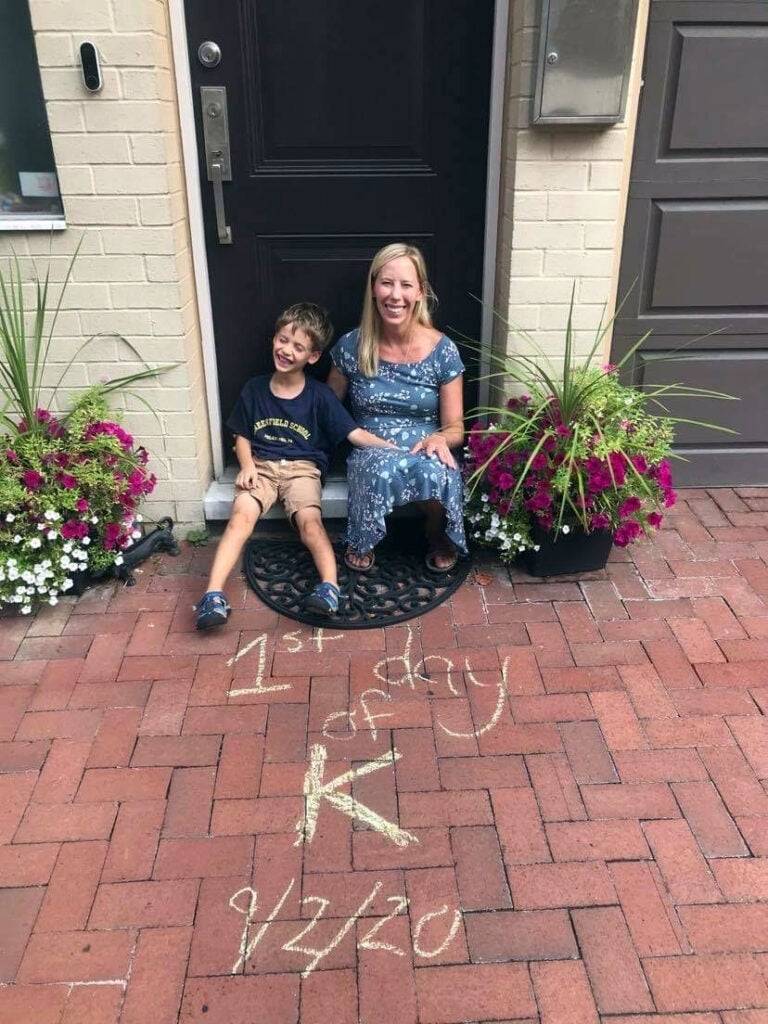
Amy Liesenfeld Blumenthal sits with her son, Joseph, outside their home. (Courtesy of Amy Liesenfeld Blumenthal)
She hopes that sending Jaxon back to the building will allow her to focus more on supporting Logan. She’s been single-handedly helping both her kids at home for the past nine months, taking time away from running her small business.
“By the time 3 o’clock rolls around, I’m fried. My brain is fried. My nerves are shot,” said Bauer.
Bauer isn’t too concerned about COVID-19 spread. She’s witnessed most of her neighbors’ kids attend Catholic school this year without a problem.
“If he starts off and I’m not comfortable with it I can always pull him out.”
Amy Liesenfeld Blumenthal is excited for her son Joseph to start in-person kindergarten at Albert Greenfield School in Center City. Her main priority is getting him into a routine, and giving him a taste of what school is like.
“Every time I’ve mentioned that school is going to open,” she said, “his face just lights up like it’s Christmas morning. For us, that’s enough of a reason to get him there.”
Blumenthal recognizes school will not be back to normal, and is concerned his first experience will be a bad one. For that reason, “I told my son, if you don’t like it, you don’t have to do it.”
Joseph is one of two students from his class returning to the building. His teacher will be additionally instructing 21 kids at home, and monitoring four other kids from another class.
“How’s that going to work? I have no idea,” she said. “I’m just gonna have to ask my son.”
Keystone Crossroads is a statewide reporting collaborative of WITF, WPSU and WESA, led by WHYY. This story originally appeared at https://whyy.org/programs/keystone-crossroads.

A collection of interviews, photos, and music videos, featuring local musicians who have stopped by the WITF performance studio to share a little discussion and sound. Produced by WITF’s Joe Ulrich.
The days of journalism’s one-way street of simply producing stories for the public have long been over. Now, it’s time to find better ways to interact with you and ensure we meet your high standards of what a credible media organization should be.